Vegetables and their nutritional values for 100grams
Tomato:
Tomato (Lycopersicum esculentum L.) is a worldwide vegetable crop. It is widely used as vegetable, soup, juice, ketchup, puree, paste and powder. Tomato is rich in vitamin C.
Tomato called with different names in other Indian languages: Takkali, Tameta, Toamaatar

Tomato Nutritional Values for 100 grams:
- Calories: 20
- Water: 94.0%
- Carbohydrates: 3.6 grams
- Protein: 0.9 grams
- Fat: 0.2 grams
- Vitamin ‘A’: 351 mgrams
- Vitamin ’B1’: 0.12 mgrams
- Vitamin ’B2’: 0.06 mgrams
- Vitamin ‘C’: 27 mgrams
- Calcium: 68 grams
- Iron: 4 grams
Eggplant:
Eggplant, (Solanum melongena), also called Brinjal, tender perennial plant of the nightshade family (Solanaceae), grown for its edible fruits. The crop is also cultivated in France, Italy and the United States of America.
Eggplant called with different names in other Indian languages: Baingan, Vankaya, Kathirikai, Brinjal
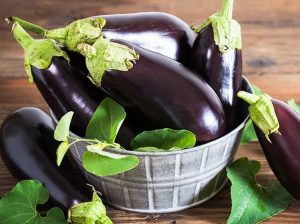
Eggplant Nutritional Values for 100 grams:
- Calories: 24
- Water: 92.7%
- Carbohydrates: 4.0 grams
- Protein: 1.4 grams
- Fat: 0.3 grams
- Vitamin ‘A’: 74 mgrams
- Vitamin ’B1’: 0.04 mgrams
- Vitamin ’B2’: 0.11 mgrams
- Vitamin ‘C’: 12 mgrams
- Calcium: 18 grams
- Iron: 9 grams
Okra:
Okra is an annual vegetable crop. It is grown all over the world in tropical and temperate regions. The tender pods are used as a vegetable.
Okra called with different names in other Indian languages: Bhendi, Ladies Finger, Okra, Bhindi, Dhenras, Vendai, bhindo, Bendekayi, Ventaykka
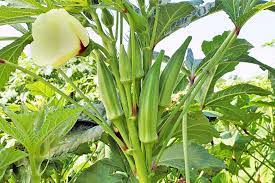
Okra Nutritional Values for 100grams:
- Calories: 35
- Water: 89.6%
- Carbohydrates: 6.4grams
- Protein: 1.9 grams
- Fat: 0.2 grams
- Vitamin ‘A’: 52 mgrams
- Vitamin ’B1’: 0.07 mgrams
- Vitamin ’B2’: 0.10 mgrams
- Vitamin ‘C’: 13 mgrams
- Calcium: 66 grams
- Iron: 5 grams
Cabbage:
Cabbage (Brassica oleraceae var. capitata) is one of the most important winter vegetables. The Portuguese introduced this crop to India. Later it gained importance during the rule of the British. Its leaf cabbage is an economically important component.
Cabbage called with different names in other Indian languages: Patta Gobi
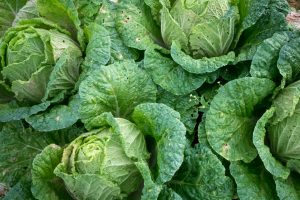
Cabbage Nutritional Values for 100grams:
- Calories: 27
- Water: 91.9%
- Carbohydrates: 4.6 grams
- Protein: 1.8 grams
- Fat: 0.1 grams
- Vitamin ‘A’: 1200 mgrams
- Vitamin ’B1’: 0.06 mgrams
- Vitamin ’B2’: 0.09 mgrams
- Vitamin ‘C’: 124 mgrams
- Calcium: 39 grams
- Iron: 8 grams
Cauliflower:
Cauliflower is one of the most important winter crops. This crop is mainly cultivated for its tender flowers. Cauliflower is rich in minerals like potassium, sodium, iron, phosphorus, calcium and magnesium.
Cauliflower called with different names in other Indian languages: Gobi
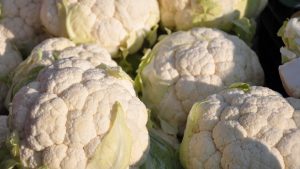
Cauliflower Nutritional Values for 100grams:
- Calories: 30
- Water: 90.8%
- Carbohydrates: 4.0 grams
- Protein: 2.6 grams
- Fat: 0.4 grams
- Vitamin ‘A’: 30 mgrams
- Vitamin ’B1’: 0.04 mgrams
- Vitamin ’B2’: 0.03 mgrams
- Vitamin ‘C’: 56 mgrams
- Calcium: 33 grams
- Iron: 5 grams
Dolichos:
Dolichos have been cultivated in our country since ancient times. It is widely cultivated in Tamil Nadu, Karnataka, Andhra Pradesh, Telangana, Madhya Pradesh and Maharashtra.
Dolichos called with different names in other Indian languages: Choli, Chettu Chikkudu, Ponchee Kai, Achinga
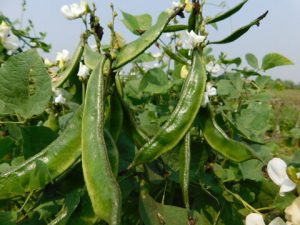
Dolichos Nutritional Values for 100grams:
- Calories: 48
- Water: 86.1%
- Carbohydrates: 6.7 grams
- Protein: 3.8 grams
- Fat: 0.7 grams
- Vitamin ‘A’: 187 mgrams
- Vitamin ’B1’: 0.10 mgrams
- Vitamin ’B2’: 0.06 mgrams
- Vitamin ‘C’: 24 mgrams
- Calcium: 50 grams
- Iron: 7 grams
French Beans:
French beans (Phaseolus vulgaris L.) are belonging to the bean’s family. French beans are native to South America.
French Beans called with different names in other Indian languages: Chukkudukaya
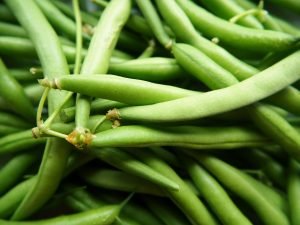
French Beans Nutritional Values for 100grams:
- Calories: 26
- Water: 91.4%
- Carbohydrates: 4.5 grams
- Protein: 1.7 grams
- Fat: 0.1 grams
- Vitamin ‘A’: 132 mgrams
- Vitamin ’B1’: 0.08 mgrams
- Vitamin ’B2’: 0.06 mgrams
- Vitamin ‘C’: 9 mgrams
- Calcium: 20 grams
- Iron: 5 grams
Cluster Beans:
Cluster beans are rich in fibers and potassium. They include fewer calories and fat and more plant proteins. They enhance heart health by lowering cholesterol, maintaining blood pressure and vessel blood flow, and lowering bad cholesterol.
Cluster Beans called with different names in other Indian languages: Guar-Ki-Phalli, Goruchikkudu, Kothavara, Gokarakaya
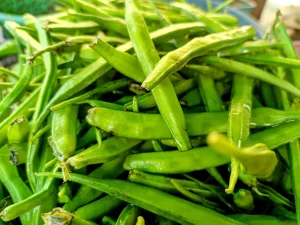
Cluster Beans Nutritional Values for 100grams:
- Calories: 16
- Water: 81.0%
- Carbohydrates: 10.8 grams
- Protein: 3.2 grams
- Fat: 0.4 grams
- Vitamin ‘A’: 198 mgrams
- Vitamin ’B1’: 0.09 mgrams
- Vitamin ’B2’: 0.03 mgrams
- Vitamin ‘C’: 49 mgrams
- Calcium: 130 grams
- Iron: 5 grams
Pea:
Pea or green pea is one of the major food legumes in the world. Scientifically known as Pisum sativum. Pea is a winter crop. It is cultivated as Rabi crop.
Pea called with different names in other Indian languages: Batanilu, haree matar
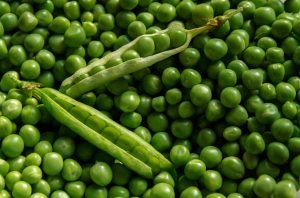
Pea Nutritional Values for 100grams:
- Calories: 96
- Water: 72.1%
- Carbohydrates: 15.9 grams
- Protein: 7.2 grams
- Fat: 0.1 grams
- Vitamin ‘A’: 83 mgrams
- Vitamin ’B1’: 0.25 mgrams
- Vitamin ’B2’: 0.01 mgrams
- Vitamin ‘C’: 9 mgrams
- Calcium: 20 grams
- Iron: 5 grams
Moringa:
Moringa has become a popular household perennial plant in India. But now, with the availability of annual varieties, farmers are showing interest in cultivating Moringa in commercial mode keeping in mind the demand for Moringa.
Moringa called with different names in other Indian languages: Munnakaya, Mulaku Kada, Muringakkai, Nuggekai, Saigan
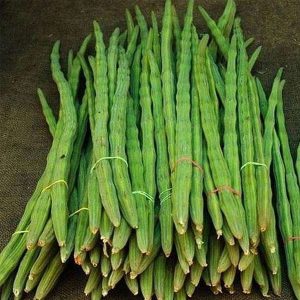
Moringa Nutritional Values for 100grams:
- Calories: 26
- Water: 86.9%
- Carbohydrates: 3.7 grams
- Protein: 2.5 grams
- Fat: 0.1 grams
- Vitamin ‘A’: 110 mgrams
- Vitamin ’B1’: 0.05 mgrams
- Vitamin ’B2’: 0.07 mgrams
- Vitamin ‘C’: 120 mgrams
- Calcium: 30 grams
- Iron: 3 grams
Bitter Gourd:
Bitter Gourd is rich in vitamins, calcium, iron, mineral salts, fat, carbohydrates and fiber.
Bitter Gourd called with different names in other Indian languages: Kakarkay, karela, pakarkay
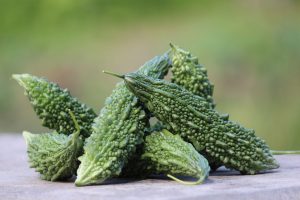
Bitter Gourd Nutritional Values for 100grams:
- Calories: 25
- Water: 92.4%
- Carbohydrates: 4.2 grams
- Protein: 1.6 grams
- Fat: 0.2 grams
- Vitamin ‘A’: 126 mgrams
- Vitamin ’B1’: 0.07 mgrams
- Vitamin ’B2’: 0.09 mgrams
- Vitamin ‘C’: 88 mgrams
- Calcium: 20 grams
- Iron: 8 grams
Bottle Gourd:
Bottle Guard (Lagenaria siceraria L.) is widely cultivated in North India. The green and tender fruits are used as a vegetable. Bottle Guard vine is an annual crop. One of the important climber vegetables of our state.
Bottle Gourd called with different names in other Indian languages: Mentha , Pudina, Spearmint

Bottle Gourd Nutritional Values for 100grams:
- Calories: 12
- Water: 96.1%
- Carbohydrates: 2.5 grams
- Protein: 0.2 grams
- Fat: 0.1 grams
- Vitamin ’B1’: 0.03 mgrams
- Vitamin ’B2’: 0.01 mgrams
- Calcium: 20 grams
- Iron: 8 grams
Ridge Gourd:
Ridge gourd is extremely rich in dietary fibre and enriched with all the vital elements that include Vitamin-C, zinc, iron, riboflavin, magnesium, thiamine and traces of another minerals.
Ridge Gourd called with different names in other Indian languages: Gilki, BeeraKayi, Pirkkankai, Peechinga

Ridge Gourd Nutritional Values for 100grams:
- Calories: 17
- Water: 95.2%
- Carbohydrates: 3.4 grams
- Protein: 0.5 grams
- Fat: 0.1 grams
- Vitamin ‘A’: 33 mgrams
- Vitamin ’B2’: 0.01 mgrams
- Vitamin ‘C’: 5 mgrams
- Calcium: 18 grams
- Iron: 5 grams
Snake Gourd:
The vegetable, along with its seeds, juice and leaf extracts, is rich in various essential dietary compounds such as fibers, fats, carbohydrates and proteins. In addition, it also contains healthful antioxidants like vitamin E and C.
Snake Gourd called with different names in other Indian languages: Podalankai , PotlaKaya, Chachinda Padavalam, Padval

Snake Gourd Nutritional Values for 100grams:
- Calories: 13
- Water: 94.6 %
- Carbohydrates: 3.3 grams
- Protein: 0.5 grams
- Fat: 0.3 grams
- Vitamin ‘A’: 96 mgrams
- Vitamin ’B1’: 0.04 mgrams
- Vitamin ’B2’: 0.06 mgrams
- Calcium: 26 grams
- Iron: 03 grams
Ash Gourd:
Ash gourd (Benincasa hispida Thunb.) is used in auspicious works, for making wadiyas and for making a sweet called ‘peta’. There is an ash-like layer on the fruit that’s why it is called ash gourd.
Ash Gourd called with different names in other Indian languages: Boodida Gummadikaya, Kaddoo

Ash Gourd Nutritional Values for 100grams:
- Calories: 10
- Water: 96.7 %
- Carbohydrates: 1.9 grams
- Protein: 0.4 grams
- Fat: 0.1 grams
- Vitamin ’B1’: 0.06 mgrams
- Vitamin ’B2’: 0.01 mgrams
- Vitamin ’C’: 1 mgrams
- Calcium: 30 grams
- Iron: 03 grams
Sweet Pumpkin:
Sweet Pumpkin (Cucurbita moschata Poir) is used in auspicious works, its pulp is used to make halwa and it is rich in vitamin A.
Sweet Pumpkin called with different names in other Indian languages: Gummadikaya, Kaddoo
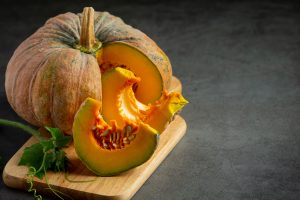
Sweet Pumpkin Nutritional Values for 100grams:
- Calories: 25
- Water: 92.6%
- Carbohydrates: 4.6 grams
- Protein: 1.4 grams
- Fat: 0.1 grams
- Vitamin ‘A’: 50 mgrams
- Vitamin ’B1’: 0.06 mgrams
- Vitamin ’B2’: 0.04 mgrams
- Vitamin ‘C’: 2 mgrams
- Calcium: 10 grams
- Iron: 7 grams
Cucumber:
It’s high in beneficial nutrients, as well as certain plant compounds and antioxidants that may help treat and even prevent some conditions.
Cucumber called with different names in other Indian languages: Kheera, Vellarikka, Vellarikka, Dosakaya

Cucumber Nutritional Values for 100grams:
- Calories: 13
- Water: 96.3%
- Carbohydrates: 2.5 grams
- Protein: 0.4 grams
- Fat: 0.1 grams
- Vitamin ‘A’: 0 mgrams
- Vitamin ’B1’: 0.03 mgrams
- Vitamin ‘C’: 7 mgrams
- Calcium: 10 grams
- Iron: 5 grams
Ivy Gourd:
Ivy Gourd (Coccinia grandis) is one of the perennial vining vegetables that bear fruits almost throughout the year. Ivy gourd is cultivated in eastern and southern regions of the country.
Ivy Gourd called with different names in other Indian languages: Dondakaya, Donda

Ivy Gourd Nutritional Values for 100grams:
- Calories: 18
- Water: 93.5%
- Carbohydrates: 3.1 grams
- Protein: 1.2 grams
- Fat: 0.1 grams
- Vitamin ‘A’: 156 mgrams
- Vitamin ’B1’: 0.07 mgrams
- Vitamin ’B2’: 0.08 mgrams
- Vitamin ‘C’: 15 mgrams
- Calcium: 40 grams
- Iron: 4 grams
Spine Gourd:
The tender spine gourds are used as a vegetable. Spine Gourd roots are used for the prevention of diseases related to digestive and urinary system.
Spine Gourd called with different names in other Indian languages: Bodakakara, Bonthakakara, Junglikarela, Kakrol, Karkotaki
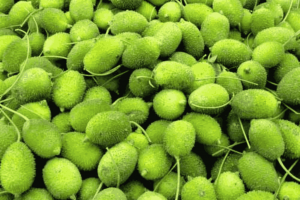
Spine Gourd Nutritional Values for 100grams:
- Calories: 52
- Water: 84.1%
- Carbohydrates: 7.7 grams
- Protein: 3.1 grams
- Fat: 1.0 grams
- Vitamin ‘A’: 1620 mgrams
- Vitamin ’B1’: 0.05 mgrams
- Vitamin ’B2’: 0.18 mgrams
- Calcium: 33 grams
- Iron: 6 grams
Capsicum:
Capsicum (Bangalore mirchi) (Capsicum annuum L.) is non-spicy and bell-shaped. Hence it is also known as “bell pepper”and it is a winter crop and grows well in cool places like Shimla. Hence it is also known as ‘Shimla Mirchi’. It is rich in vitamin ‘A’ and ‘C’.
Capsicum called with different names in other Indian languages: Shimala Mirchi, Mirchi, Kuramirapa
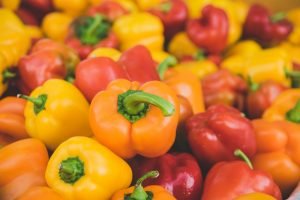
Capsicum Nutritional Values for 100grams:
- Calories: 29
- Water: 92.4%
- Carbohydrates: 4.3 grams
- Protein: 1.2 grams
- Fat: 0.3 grams
- Vitamin ‘A’: 870 mgrams
- Vitamin ’B1’: 0.06 mgrams
- Vitamin ’B2’: 0.03 mgrams
- Vitamin ‘C’: 321 mgrams
- Calcium: 11.0 grams
- Iron: 2 grams
Carrot:
Carrot is recognized as a good nutritional food due to its high content of proteins, salts and vitamins along with vitamin-A.
Carrot called with different names in other Indian languages: Gajar, Karotte
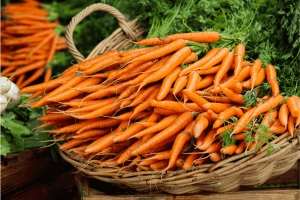
Carrot Nutritional Values for 100grams:
- Calories: 48
- Water: 86.0%
- Carbohydrates: 10.6 grams
- Protein: 0.9 grams
- Fat: 0.2 grams
- Vitamin ‘A’: 1890 mgrams
- Vitamin ’B1’: 0.04 mgrams
- Vitamin ’B2’: 0.02 mgrams
- Vitamin ‘C’: 3 mgrams
- Calcium: 80 grams
- Iron: 2 grams
Radish:
Radish has a prominent place among beetroots, which are useful not only for body nutrition but also for health protection. Especially with the property of increasing appetite, it also keeps kidney diseases under control.
Radish called with different names in other Indian languages: Mooli, mullangi
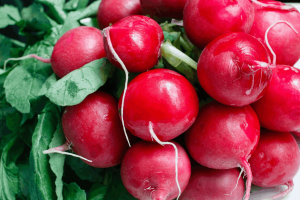
Radish Nutritional Values for 100grams:
- Calories: 17
- Water: 94.4%
- Carbohydrates: 3.4 grams
- Protein: 0.7 grams
- Fat: 0.1 grams
- Vitamin ‘A’: 3 mgrams
- Vitamin ’B1’: 0.06 mgrams
- Vitamin ’B2’: 0.02 mgrams
- Vitamin ‘C’: 15 mgrams
- Calcium: 35 grams
- Iron: 04 grams
Beetroot:
It is also used in the preparation of vegetables and pickles. Consuming beets leads to a large intake of nitrate, which has many purported health benefits. Most notably, nitrate helps to lower blood pressure.
Beetroot called with different names in other Indian languages: Chukkandr, Chekkara Dumpalu, Biitt
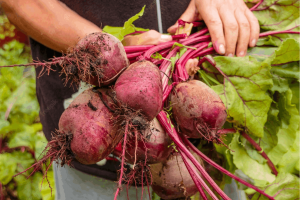
Beetroot Nutritional Values for 100grams:
- Calories: 43
- Water: 87.7%
- Carbohydrates: 8.8 grams
- Protein: 1.7 grams
- Fat: 0.1 grams
- Vitamin ‘A’: 0 mgrams
- Vitamin ’B1’: 0.04 mgrams
- Vitamin ’B2’: 0.09 mgrams
- Vitamin ‘C’: 10 mgrams
- Calcium: 18 grams
- Iron: 0 grams
Taro root:
Taro roots are boiled or fried or roasted over fire and used to make curry. Taro root is rich in carbohydrates, calcium, iron, phosphorus, vitamin ‘A’ and ‘C’.
Taro root called with different names in other Indian languages: Arbi, Chama Dumpa, Chempu, Kachu
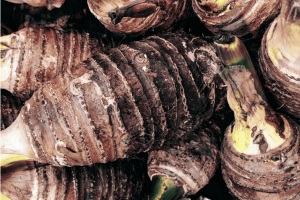
Taro root Nutritional Values for 100grams:
- Calories: 97
- Water: 74.7%
- Carbohydrates: 22.6 grams
- Protein: 1.6 grams
- Fat: 0.1 grams
- Vitamin ‘A’: 24 mgrams
- Vitamin ’B1’: 0.09 mgrams
- Vitamin ’B2’: 0.03 mgrams
- Vitamin ‘C’: 0 mgrams
- Calcium: 40 grams
- Iron: 7 grams
Potato:
They’re rich in vitamin C, which is an antioxidant. Potatoes were a life-saving food source in early times because the vitamin C prevented scurvy.
Potato called with different names in other Indian languages: Bangaala Dumpa, Urulakizhangu, Aloo, Batata
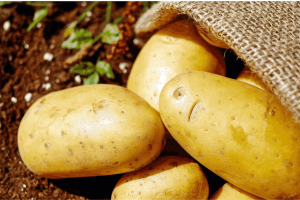
Potato Nutritional Values for 100grams:
- Calories: 97
- Water: 74.7%
- Carbohydrates: 22.6 grams
- Protein: 1.6 grams
- Fat: 0.1 grams
- Vitamin ‘A’: 24 mgrams
- Vitamin ’B1’: 0.10 mgrams
- Vitamin ’B2’: 0.10 mgrams
- Vitamin ‘C’: 17 mgrams
- Calcium: 10 grams
- Iron: 7 grams
Sweet Potato:
Sweet potatoes are versatile and nutritious, packing a good amount of vitamin A, vitamin C, and manganese into each serving.
Sweet Potato called with different names in other Indian languages: Cilakada dumpa, Carkkaraivallikkilanku, shakar kand, Genasu
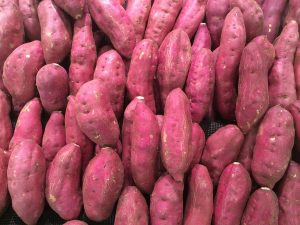
Sweet Potato Nutritional Values for 100grams:
- Calories: 120
- Water: 68.5%
- Carbohydrates: 28.2 grams
- Protein: 1.2 grams
- Fat: 0.3 grams
- Vitamin ‘A’: 6 mgrams
- Vitamin ’B1’: 0.08 mgrams
- Vitamin ’B2’: 0.04 mgrams
- Vitamin ‘C’: 24 mgrams
- Calcium: 46 grams
- Iron: 08 grams
Elephant Foot Yam:
Kanda is a carb and protein rich vegetable, loaded with zinc, phosphorous, potassium, Vitamin B6, Vitamin A and calcium.
Elephant Foot Yam called with different names in other Indian languages: Suran, Kanda gadda, chena

Elephant Foot Yam Nutritional Values for 100grams:
- Calories: 79
- Water: 78.7%
- Carbohydrates: 18.4 grams
- Protein: 1.2 grams
- Fat: 0.1 grams
- Vitamin ‘A’: 260 mgrams
- Vitamin ’B1’: 0.06 mgrams
- Vitamin ’B2’: 0.07 mgrams
- Vitamin ‘C’: 0 mgrams
- Calcium: 50 grams
- Iron: 6 grams
Onion:
Onions contain antioxidants and compounds that fight inflammation, decrease triglycerides, and reduce cholesterol levels.
Onion called with different names in other Indian languages: Ullipaya, Ulligadda, Pyajj, Vengayam, Ulli
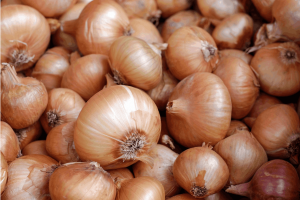
Onion Nutritional Values for 100grams:
- Calories: 50
- Water: 86.6%
- Carbohydrates: 11.1 grams
- Protein: 1.2 grams
- Fat: 0.1 grams
- Vitamin ‘A’: 0 mgrams
- Vitamin ’B1’: 0.08 mgrams
- Vitamin ’B2’: 0.01 mgrams
- Vitamin ‘C’: 11 mgrams
- Calcium: 47 grams
- Iron: 7 grams
Garlic:
Garlic is used as a spice in different crop seasons. Moreover, garlic has many medicinal properties and is also used as a cure for various diseases.
Garlic called with different names in other Indian languages: Velluli, veluttulli, bellulli, rasuna, lasana
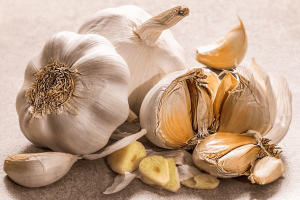
Garlic Nutritional Values for 100grams:
- Water: 62.8%
- Carbohydrates: 19.0 grams
- Protein: 6.3 grams
- Fat: 0.1 grams
- Vitamin ‘A’: 0 mgrams
- Vitamin ‘C’: 13 mgrams
- Calcium: 0.03 grams
- Iron: 001 grams
Watermelon:
Watermelon is a sweet and refreshing low calorie summer snack. It provides hydration and also essential nutrients, including vitamins, minerals, and antioxidants.
Watermelon called with different names in other Indian languages: Puchakayi, Darbusini, Kallangadi, Tarbuj
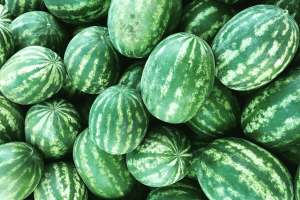
Watermelon Nutritional Values for 100grams:
- Calories: 16
- Water: 95.8%
- Carbohydrates: 3.3 grams
- Protein: 0.2 grams
- Fat: 0.2 grams
- Vitamin ‘A’: 0 mgrams
- Vitamin ’B1’: 0.02 mgrams
- Vitamin ’B2’: 0.04 mgrams
- Vitamin ‘C’: 1 mgrams
- Calcium: 11 grams
- Iron: 9 grams
Muskmelon:
The numerous health benefits of this musk melon can be attributed to its rich nutritional content that is necessary for healthy body functioning.
Muskmelon called with different names in other Indian languages: Kharbooja, Parangi pazham, Kasthuri Mathan
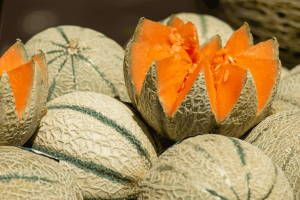
Muskmelon Nutritional Values for 100grams:
- Calories: 17
- Water: 95.2%
- Carbohydrates: 3.5 grams
- Protein: 0.3 grams
- Fat: 0.2 grams
- Vitamin ‘A’: 169 mgrams
- Vitamin ’B1’: 0.11 mgrams
- Vitamin ’B2’: 0.08 mgrams
- Vitamin ‘C’: 26 mgrams
- Calcium: 32 grams
- Iron: 1 grams
Follow WalPencil to get to know cultivation tips for other vegetable crops like Taro root, Tomato, Carrot, Radish, Eggplant Green Vegetables Nutritional values etc.
